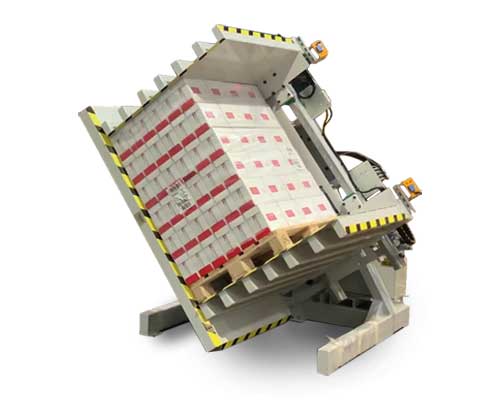# Why Pallet Inverters Are the Secret Weapon of Modern Warehousing
The Hidden Costs of Manual Pallet Handling
Manual pallet handling is a silent productivity killer. From damaged goods to workplace injuries, the risks of relying on human labor for repetitive tasks are staggering. Studies show that up to 25% of product damage occurs during manual pallet transfers, while musculoskeletal injuries from lifting heavy loads cost businesses millions annually. Enter the pallet inverter—a game-changing solution that automates the transfer of goods between pallets, eliminating these risks while slashing operational costs.

What Exactly Is a Pallet Inverter?
A pallet inverter is a specialized machine designed to transfer entire stacks of goods from one pallet to another. Using a rotating frame, it flips loads up to 180 degrees with precision, making it ideal for replacing damaged pallets, straightening tilted stacks, or switching to hygiene-compliant pallets. Unlike forklifts, which require careful operation to avoid accidents, pallet inverters handle loads as heavy as 3,300 lbs (1,500 kg) at speeds of up to 50 pallets per hour—all without human intervention.
Breaking Down the Investment: Costs vs. Long-Term Savings
Initial Costs: A Range of Options
Pallet inverters vary in price based on capacity and features. Entry-level models start at a few thousand dollars, while heavy-duty systems like the Premier FS 1600 Single Clamp Pallet Inverter—a mid-range workhorse—cost significantly more. However, even high-end models typically pay for themselves within 12–18 months through labor savings and reduced product damage.
Operational and Maintenance Costs
These machines are energy-efficient, consuming minimal power during operation. Maintenance is straightforward, requiring only periodic checks by technicians. For example, Toppy Holland’s inverters are built with durability in mind, ensuring low lifetime maintenance costs compared to the recurring expenses of manual labor.

ROI Revealed: How Automation Pays for Itself
Labor Savings: Doing More with Less
A single pallet inverter can replace 2–3 workers tasked with manually transferring loads. For a mid-sized warehouse, this translates to annual savings of $150,000–$200,000 in wages alone. Employees are also freed to focus on higher-value tasks, such as quality control or inventory management.
Reducing Product Damage: A Game-Changer for Profit Margins
Forklifts and manual handling often lead to crushed boxes, spilled materials, or unstable stacks. Pallet inverters eliminate these issues by securing loads with hydraulic clamps during rotation. One food distributor reported a 90% drop in damaged goods after adopting inversion technology, saving $50,000 monthly in replacement costs.
Safety: Cutting Workers’ Compensation Claims
By removing the need for heavy lifting, businesses see a dramatic reduction in workplace injuries. A Midwest pharmaceutical company reduced strain-related injuries by 70% within six months of installing pallet inverters, lowering insurance premiums and boosting employee morale.
Choosing the Right Pallet Inverter: Key Considerations
Load Size and Variety
For uniform loads (e.g., standardized boxes), compact models suffice. Operations handling mixed loads—like construction materials or fragile food items—require inverters with adjustable clamp ranges and pressure settings. Premier’s FSDC Dual Clamp Inverter, for instance, accommodates pallets from 30″ to 60″ wide, making it ideal for diverse industries.
Volume and Space Constraints
High-volume facilities benefit from inline systems integrated into conveyor networks, while smaller warehouses might opt for standalone units like the Top Industries 180° Inverter, which fits into tight spaces.
Industry-Specific Needs
- Food & Beverage: Stainless steel inverters for hygiene compliance.
- Chemicals: Leak-proof models to prevent cross-contamination.
- **C
Real-World Applications: Industries Transformed
Case Study 1: Streamlining Cheese Production
A dairy producer used pallet inverters to rotate cheese blocks during aging, ensuring even flavor development. This reduced manual handling by 80% and cut production time by 15%.
Case Study 2: Solving Pallet Recycling in Retail
A major retailer saved $200,000 annually by transferring goods from expensive CHEP pallets to disposable ones before shipping. The inverter paid for itself in eight months.
Case Study 3: Disaster Recovery in Pharmaceuticals
When a shipment of vaccines arrived on damaged pallets, a pharma company used its inverter to transfer the entire load to sterile pallets in under 30 minutes—avoiding a $2 million loss.
Future-Proofing Your Warehouse: The Long-Term Edge
Pallet inverters aren’t just a quick fix; they’re a strategic investment. As e-commerce drives demand for faster, error-free logistics, automation becomes non-negotiable. Modern inverters integrate with IoT-enabled warehouse systems, providing real-time data on load status and maintenance needs. For example, Top Industries’ advanced models offer predictive maintenance alerts, reducing downtime by 40%.

The Bottom Line
The math is clear: A $50,000 pallet inverter saving $200,000 annually delivers a 300% ROI in Year 1. But beyond the numbers, it’s about staying competitive in an era where speed and safety define success. Whether you’re a small distributor or a global manufacturer, the question isn’t “Can I afford a pallet inverter?”—it’s “Can I afford not to have one?”
From reducing product waste to safeguarding your workforce, pallet inversion technology isn’t just an upgrade—it’s a revolution. And with industry leaders like Toppy Holland and Premier Handling Solutions offering customizable solutions, there’s never been a better time to automate.

![8 Critical Factors When Choosing a Wire Coil Wrapping Machine [2025 Buyer’s Guide] 8 Critical Factors When Choosing a Wire Coil Wrapping Machine [2025 Buyer’s Guide]](https://i0.wp.com/www.fhopepack.com/blog/wp-content/uploads/2023/01/Master-coil-stretch-wrapper-zt.webp?w=1024&resize=1024,1024&ssl=1)


